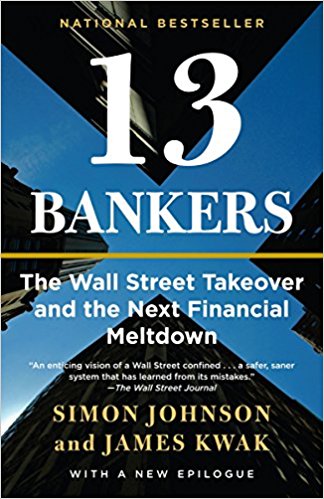13 Bankers Summary

4 min read ⌚
 The Wall Street Takeover and the Next Financial Meltdown
The Wall Street Takeover and the Next Financial Meltdown
At this moment, when you think of the American financial power you are thinking of a synonym of America’s big banks. However, that was not always the case. Even before he became president, Thomas Jefferson was careful about big banks.
Who Should Read “13 Bankers”? And Why?
“13 Bankers” is a book that charts the rise to immense power of the financial sector. Compellingly, this narrative examines the reasons that, Wall Street, even during the appearance of the new world order after the enormous 2007-2009 financial crash, is the same.
Presenting this premise – that the legislature must separate the big banks counters the tried and true way of thinking. In this way, the book is entertaining and compelling. Readers state that it is one of the best books on the financial crisis they have ever read.
We recommend this timely account of the troubled political economy to all readers who would like to gain insight into the history of Wall Street and how it functions.
About Simon Johnson
 Simon Johnson is a British American economist. He teaches Entrepreneurship at the MIT Sloan School of Management and is a senior fellow at the Peterson Institute for International Economics.
Simon Johnson is a British American economist. He teaches Entrepreneurship at the MIT Sloan School of Management and is a senior fellow at the Peterson Institute for International Economics.
James Kwak teaches Law at the University Of Connecticut’s School Of Law. They are best known as the co-founders of the economics blog “The Baseline Scenario.”
“13 Bankers Summary”
In the late 80s and mid-’90s, George Washington’s Treasury secretary, Alexander Hamilton, contradicted Jefferson and battled to build the National Bank of the U.S. to deal with the state’s cash.
Jefferson and James Madison, his presidential successor, created the Democrat-Republican Party to contradict Hamilton’s Federalist Party and a central, national bank.
While on the one hand, Hamilton had rightly argued that a national bank would create efficiency, Jefferson on the other hand, was right that large financial establishments would achieve immense power.
The blend of Wall Street’s domination and insufficient regulatory authority demonstrated harmful in the 20s when presidents Warren Harding and Calvin Coolidge incited deregulation. Their hands-off approach let the bankers eager to take part in dangerous, speculative markets.
The 1929 crash and the Great Depression prompted tighter bank control. Under Roosevelt, the state took even firmer control. Government controllers set the tenets, and banks followed the “3-6-3 lead”: Pay 3% on investment funds, give loans at 6% and hit the golf course by 3 p.m.
Until the late 70s, the U.S. had a stable managing and accounting framework. Bank disappointments were practically nonexistent. The stable banking system of the U.S. lasted until the late 70s. However, as directions fell, another tried and true way of thinking grabbed hold: the “Efficient Market Hypothesis.”
The simplistic version of the hypothesis suggested that if bankers did a transaction, it was precisely priced and beneficial to everybody included.
Money Street overindulgence peaked in the mid-2000s when banks recklessly collateralized debt commitments and various other instruments that empowered borrowers to purchase more property than they could afford.
Helped by government policies enabling home proprietorship, banks offered mortgage loans to all individuals. Therefore, borrowers took out credits their wages could not bolster for mortgages that relied upon continued value appreciation.
However, the IMF research contended that the subprime fever postured minimal systematic risk.
At that point, property costs stopped increasing, and things started going downwards. A few banks collapsed, while the surviving banks, facing little change, just got bigger. 13 leaders of the U.S’s. Biggest banks went to President Barack Obama in March 2009.
However, they heard little intimidating words – the President chose not to destroy the system that had generated the calamity. Instead, he supported the bankers, demonstrating the ingrained reverberation of Wall Street’s ideology. Money Street has developed the idea that its values reflect the values of the country and the world.
Big banks have a long time now supported this contention with multitudes of lobbyists and powerful political commitments. However, the ideology is their most effective weapon. At the point when the business sectors fell, politicians started to doubt Wall Street’s insight.
Nonetheless, its reasoning was so implanted in their brains that they were responsive to the bankers’ contentions against stricter regulations.
Key Lessons from “13 Bankers”
1. Capitalism’s Cultural Capital: Money
2. Capitalism’s Cultural Capital: Influence
3. Capitalism’s Cultural Capital: Cultural Capital
Capitalism’s Cultural Capital: Money
The financial sector is the most significant benefactor to U.S. politics. In 2006 it fueled campaign with $260 million, with health care coming next, with $100 million.
By 2009, Senator Dick Durbin called banks “the most powerful lobby on Capitol Hill.”
Capitalism’s Cultural Capital: Influence
Wall Street routinely carries officials into vital government employment. Treasury secretaries Henry Paulson, under George W. Bramble and Robert Rubin, under Clinton, independently ran Goldman Sachs amid the new era of outsized hazard.
Reagan’s Treasury head, Donald Regan, once presided Merrill Lynch.
Capitalism’s Cultural Capital: “Cultural capital”
Capitalism stopped to be upsetting in the 1990s. This situation enormously helped Wall Street’s campaigning.
It is one thing for a primary interest like Big Tobacco to pay for off-camera maneuvering. It is quite another thing when a primary interest’s ideal is so famous and acknowledged that government officials of all stripes support its objectives.
Like this summary? We’d Like to invite you to download our free 12 min app, for more amazing summaries and audiobooks.
“13 Bankers” Quotes
The right solution is obvious: do not allow financial institutions to be too big to fail; break up the ones that are. Share on X The recent orgy of financial innovation turned out so badly because financial innovation is not like technological innovation. Share on X The unprecedented amounts of money flowing through the financial sector, increasingly concentrated in a handful of megabanks...the foundation of a new financial oligarchy. Share on X So long as the political establishment remained captive to the idea that America needs big, sophisticated, risk-seeking highly profitable banks, they had the upper hand in any negotiation. Share on X The confrontation between concentrated financial power and democratically elected government is as old as the American republic. Share on XOur Critical Review
In this book, authors Simon Johnson and James Kwak, contend that the world was too nice to Wall Street for quite a long time and that the time has come to separate big banks.
Indeed, at the moment we live in a world where cash and power are held in a smaller number of hands. However, Wall Street’s underlying ideology, which favors losing control and markets ruled by a couple of large banks, continues to live on.








